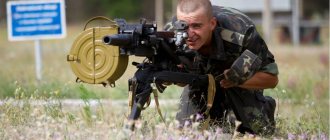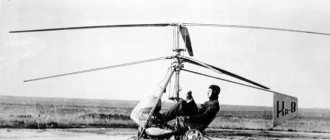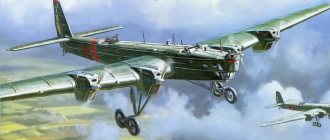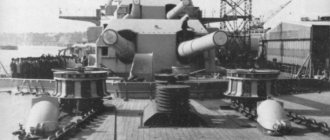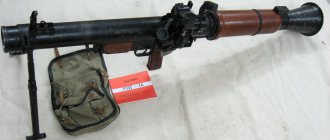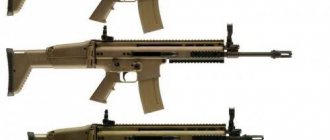Man-portable anti-aircraft missile systems (MANPADS) are a fairly young type of weapon. MANPADS are difficult to develop and manufacture, so there are not many models and they are produced only in some countries. However, among them there was (and still is) an installation that for a long time was the most famous representative of the class.
Just as “Bazooka” for some time became the collective name for all anti-tank grenade launchers, portable anti-aircraft missiles were associated specifically with the “Stinger”. Now, of course, the Stinger is no longer the most famous and effective system - but it remains one of the most common models.
History of creation
The development of an anti-aircraft missile launcher that could be used by infantrymen in the United States began back in the 50s. The result of the work was the FIM-43 Red Eye MANPADS. The first shoulder-launched anti-aircraft missile took place in 1961. Red Eye proved the viability of the idea of man-portable anti-aircraft missile systems, but its characteristics were far from impressive.
The low sensitivity of the infrared homing head did not allow firing at targets on a collision course. Thermal traps effectively diverted the “attention” of the rocket. And the low maneuverability allowed the plane to simply dodge. Attempts to increase the effectiveness of MANPADS led to the fact that the Red Eye of the third modification was seriously different from the previous series, and only the name was common with the prototype.
Work on a new MANPADS, at that time known as Red Eye 2, began in 1969.
The project won the competition. In 1971, another competition was held to select the design of the homing head. Well, in 1972, General Dynamics received a contract for further improvement of MANPADS, which was now given the name “Stinger”.
Unexpectedly, this approach was met with hostility by Congress, which demanded that a competitive selection be held once again. The requirements were met, and at the end of the year a large-scale competition was held, in which not only American, but also European developments took part.
However, “Stinger” and the project, which remained in history as the “alternative Stinger,” reached the finals. But more on that later. The development of the Stinger took another 4 years. In 1978, mass production was launched, and since 1981, MANPADS began to enter service with the troops.
An excerpt characterizing the FIM-92 Stinger
The whole way Petya was preparing for how he would behave with Denisov, as a big man and an officer should, without hinting at a previous acquaintance. But as soon as Denisov smiled at him, Petya immediately beamed, blushed with joy and, forgetting the prepared formality, began to talk about how he drove past the French, and how glad he was that he had been given such an assignment, and that he was already in battle near Vyazma, and that one hussar distinguished himself there. “Well, I hate to see you,” Denisov interrupted him, and his face again took on a preoccupied expression. “Mikhail Feoklitich,” he turned to the esaul, “after all, this is again from a German.” He doesn't consist of anything. “And Denisov told the esaul that the contents of the paper brought now consisted of a repeated demand from the German general to join in an attack on the transport. “If we don’t take it tomorrow, they’ll kick it out from under our noses,” he concluded. While Denisov was talking to the esaul, Petya, embarrassed by Denisov’s cold tone and assuming that the reason for this tone was the position of his trousers, so that no one would notice, straightened his fluffed trousers under his overcoat, trying to look as militant as possible. - Will there be any order from your honor? - he said to Denisov, putting his hand to his visor and again returning to the game of adjutant and general, for which he had prepared, - or should I remain with your honor? “Orders?” Denisov said thoughtfully. -Can you stay until tomorrow? - Oh, please... Can I stay with you? – Petya screamed. - Yes, exactly what did the geneg'al tell you to do - go veg now? – Denisov asked. Petya blushed. - Yes, he didn’t order anything. I think it is possible? – he said questioningly. “Well, okay,” Denisov said. And, turning to his subordinates, he made orders that the party should go to the resting place appointed at the guardhouse in the forest and that an officer on a Kyrgyz horse (this officer served as an adjutant) should go to look for Dolokhov, to find out where he was and whether he would come in the evening . Denisov himself, with the esaul and Petya, intended to drive up to the edge of the forest overlooking Shamshev in order to look at the location of the French, at which tomorrow’s attack was to be directed. “Well, God,” he turned to the peasant conductor, “take me to Shamshev.” Denisov, Petya and the esaul, accompanied by several Cossacks and a hussar who was carrying a prisoner, drove to the left through the ravine, to the edge of the forest. The rain passed, only fog and drops of water fell from tree branches. Denisov, Esaul and Petya silently rode behind a man in a cap, who, lightly and silently stepping with his bast-clad feet on roots and wet leaves, led them to the edge of the forest. Coming out onto the road, the man paused, looked around and headed towards the thinning wall of trees. At a large oak tree that had not yet shed its leaves, he stopped and mysteriously beckoned to him with his hand. Denisov and Petya drove up to him. From the place where the man stopped, the French were visible. Now, behind the forest, a spring field ran down a semi-hillock. To the right, across a steep ravine, a small village and a manor house with collapsed roofs could be seen. In this village and in the manor's house, and throughout the hillock, in the garden, at the wells and pond, and along the entire road up the mountain from the bridge to the village, no more than two hundred fathoms away, crowds of people were visible in the fluctuating fog. Their non-Russian screams at the horses in the carts struggling up the mountain and calls to each other were clearly heard. “Give the prisoner here,” Denisop said quietly, not taking his eyes off the French. The Cossack got off his horse, took the boy off and walked up to Denisov with him. Denisov, pointing to the French, asked what kind of troops they were. The boy, putting his chilled hands in his pockets and raising his eyebrows, looked at Denisov in fear and, despite the visible desire to say everything he knew, was confused in his answers and only confirmed what Denisov was asking. Denisov, frowning, turned away from him and turned to the esaul, telling him his thoughts. Petya, turning his head with quick movements, looked back at the drummer, then at Denisov, then at the esaul, then at the French in the village and on the road, trying not to miss anything important. - Dolokhov is coming, he’s not coming, we have to beat him!.. Eh? - Denisov said, his eyes flashing merrily. “The place is convenient,” said the esaul. “We’ll send the infantry down through the swamps,” Denisov continued, “they’ll crawl up to the garden; you will come with the Cossacks from there,” Denisov pointed to the forest outside the village, “and I will come from here, with my gusags.” And according to the road... “It won’t be a hollow—it’s a quagmire,” said the esaul. “You’ll get stuck in the horses, you need to go around to the left... While they were talking in a low voice in this way, below, in the ravine from the pond, one shot clicked, smoke turned white, another, and a friendly, seemingly cheerful cry of hundreds of French voices who were on the half-mountain was heard. In the first minute, both Denisov and the esaul moved back. They were so close that it seemed to them that they were the cause of these shots and screams. But the shots and screams did not apply to them. Below, through the swamps, a man in something red was running. Apparently he was being shot at and shouted at by the French. “After all, this is our Tikhon,” said the esaul. - He! they are! “What a rogue,” Denisov said. - He will go away! - Esaul said, narrowing his eyes. The man they called Tikhon, running up to the river, splashed into it so that splashes flew, and, hiding for a moment, all black from the water, he got out on all fours and ran on. The French running after him stopped. “Well, he’s clever,” said the esaul. - What a beast! – Denisov said with the same expression of annoyance. - And what has he been doing so far? - Who is this? – Petya asked. - This is our plastun. I sent him to take the tongue. “Oh, yes,” Petya said from Denisov’s first word, nodding his head as if he understood everything, although he absolutely did not understand a single word. Tikhon Shcherbaty was one of the most necessary people in the party. He was a man from Pokrovskoye near Gzhat. When, at the beginning of his actions, Denisov came to Pokrovskoye and, as always, calling the headman, asked what they knew about the French, the headman answered, as all the headmen answered, as if defending themselves, that they didn’t know anything, to know they don't know. But when Denisov explained to them that his goal was to beat the French, and when he asked if the French had wandered in, the headman said that there were definitely marauders, but that in their village only one Tishka Shcherbaty was involved in these matters. Denisov ordered Tikhon to be called to him and, praising him for his activities, said a few words in front of the headman about the loyalty to the Tsar and the Fatherland and the hatred of the French that the sons of the Fatherland should observe. “We don’t do anything bad to the French,” said Tikhon, apparently timid at Denisov’s words. “That’s the only way we fooled around with the guys.” They must have beaten about two dozen Miroders, otherwise we didn’t do anything bad... - The next day, when Denisov, completely forgetting about this guy, left Pokrovsky, he was informed that Tikhon had attached himself to the party and asked to be left with it. Denisov ordered to leave him. Tikhon, who at first corrected the menial work of laying fires, delivering water, skinning horses, etc., soon showed greater willingness and ability for guerrilla warfare. He went out at night to hunt for prey and each time brought with him French clothes and weapons, and when he was ordered, he also brought prisoners. Denisov dismissed Tikhon from work, began to take him with him on travels and enrolled him in the Cossacks. Tikhon did not like to ride and always walked, never falling behind the cavalry. His weapons were a blunderbuss, which he wore more for fun, a pike and an ax, which he wielded like a wolf wields his teeth, equally easily picking out fleas from his fur and biting through thick bones. Tikhon equally faithfully, with all his might, split logs with an ax and, taking the ax by the butt, used it to cut out thin pegs and cut out spoons. In Denisov's party, Tikhon occupied his special, exclusive place. When it was necessary to do something especially difficult and disgusting - turn a cart over in the mud with your shoulder, pull a horse out of a swamp by the tail, skin it, climb into the very middle of the French, walk fifty miles a day - everyone pointed, laughing, at Tikhon. “What the hell is he doing, you big gelding,” they said about him. Once, the Frenchman whom Tikhon was taking shot at him with a pistol and hit him in the flesh of his back. This wound, for which Tikhon was treated only with vodka, internally and externally, was the subject of the funniest jokes in the entire detachment and jokes to which Tikhon willingly succumbed. - What, brother, won’t you? Is Ali crooked? - the Cossacks laughed at him, and Tikhon, deliberately crouching and making faces, pretending that he was angry, scolded the French with the most ridiculous curses. This incident had only the influence on Tikhon that after his wound he rarely brought prisoners. Tikhon was the most useful and brave man in the party. No one else discovered cases of attack, no one else took him and beat the French; and as a result of this, he was the jester of all the Cossacks and hussars and he himself willingly succumbed to this rank. Now Tikhon was sent by Denisov, at night, to Shamshevo in order to take the tongue. But, either because he was not satisfied with just the Frenchman, or because he slept through the night, during the day he climbed into the bushes, into the very middle of the French and, as Denisov saw from Mount Denisov, was discovered by them. After talking a little more time with the esaul about tomorrow's attack, which now, looking at the proximity of the French, Denisov seemed to have finally decided, he turned his horse and rode back. “Well, darling, now let’s go dry off,” he said to Petya. Approaching the forest guardhouse, Denisov stopped, peering into the forest. Through the forest, between the trees, a man in a jacket, bast shoes and a Kazan hat, with a gun over his shoulder and an ax in his belt, walked with long, light steps on long legs, with long, dangling arms. Seeing Denisov, this man hastily threw something into the bush and, taking off his wet hat with its drooping brim, approached the boss. It was Tikhon. His face, pitted with smallpox and wrinkles, with small, narrow eyes, shone with self-satisfied gaiety. He raised his head high and, as if holding back laughter, stared at Denisov. - Well, where did you fall? - Denisov said. - Where had you been? “I followed the French,” Tikhon answered boldly and hastily in a hoarse but melodious bass. - Why did you climb during the day? Cattle! Well, didn’t you take it?.. “I took it,” said Tikhon. - Where is he? “Yes, I took him first at dawn,” Tikhon continued, moving his flat legs turned out wider in his bast shoes, “and took him into the forest.” I see it's not okay. I think, let me go and get another more careful one. “Look, you scoundrel, that’s how it is,” Denisov said to the esaul. - Why didn’t you do this? “Why should we lead him,” Tikhon interrupted hastily and angrily, “he’s not fit.” Don't I know which ones you need? “What a beast!.. Well?..” “I went after someone else,” Tikhon continued, “I crawled into the forest in this manner, and then lay down.” – Tikhon suddenly and flexibly lay down on his belly, imagining in their faces how he did it. “One and catch up,” he continued. “I’ll rob him in this manner.” – Tikhon quickly and easily jumped up. “Let’s go, I say, to the colonel.” How loud he will be. And there are four of them here. They rushed at me with skewers. “I hit them with an ax in this manner: why are you, Christ is with you,” Tikhon cried, waving his arms and frowning menacingly, sticking out his chest. “We saw from the mountain how you asked a line through the puddles,” said the esaul, narrowing his shining eyes. Petya really wanted to laugh, but he saw that everyone was holding back from laughing. He quickly moved his eyes from Tikhon’s face to the faces of the esaul and Denisov, not understanding what it all meant. “You can’t imagine it,” Denisov said, coughing angrily. – Why didn’t peg’vogo pg’ivel? Tikhon began to scratch his back with one hand, his head with the other, and suddenly his whole face stretched into a shining, stupid smile, revealing a missing tooth (for which he was nicknamed Shcherbaty). Denisov smiled, and Petya burst into cheerful laughter, which Tikhon himself joined in. “Yes, it’s completely wrong,” said Tikhon. “The clothes he’s wearing are bad, so where should we take him?” Yes, and a rude man, your honor. Why, he says, I myself am the son of Anaral, I won’t go, he says.
Design
The anti-aircraft guided missile used in the Stinger MANPADS has a canard aerodynamic design - the horizontal tail is located in front of the main planes. In the nose of the rocket there are 2 rudders and 2 fixed aerodynamic surfaces. The rocket is stabilized by rotation - the tail stabilizers installed at an angle help maintain it in flight. The launch accelerator, whose nozzles are located obliquely, helps the rocket acquire rotation.
The sustainer engine of the Stinger rocket is solid fuel and is turned on after the rocket leaves the launch tube and is removed to a safe distance.
The warhead is a fragmentation beam and contains 3 kg of explosive. The fuse, however, is a contact fuse, requiring a direct hit on the target. If the missile misses, the self-destruct mechanism is triggered. The homing head of the MANPADS missiles of the first modification FIM-92A is all-aspect infrared.
The missile is stored in a transport and launch container in the form of a sealed plastic tube. The inside of the container-pipe is filled with inert gas, and the rocket can remain in it without requiring maintenance for up to 10 years.
Before use, a trigger mechanism is attached to the container. A block is inserted into it, which includes an electric battery and a container containing liquid argon. Also, an antenna of the “friend or foe” system is attached to the trigger mechanism. Having discovered a target, the missileman aims the MANPADS at it using an optical sight and presses the trigger. After this, the battery supplies electricity to the rocket’s on-board network, and argon cools the homing head.
The missile operator is notified of the target being captured by a sound signal and vibration of the device built into the sight. After this, you should press the trigger again - the on-board battery of the rocket is turned on, the cartridge with compressed air disconnects the power supply, and the squib launches the starting accelerator. The Stinger launch tube is disposable, and it is impossible to “reload” it with a new missile.
For use at night, the AN/PVS-4 night sight was adapted to MANPADS.
Equipped with a third-generation electro-optical converter, it allows you to identify targets at a distance of 7 km and has a magnification of 2.26 times. A thermal imaging sight designed for use with the Stinger is currently being produced in Turkey.
Upgrades and modifications
The Stinger MANPADS of the second model - FIM-92B - received an improved homing head. In addition to the infrared radiation receiver, the GPS had a second one operating in the ultraviolet spectrum. Due to this, the resistance to interference has increased, both to “natural” and to thermal traps (which are not perceived in the UV range).
In addition, in the last section of approach to the target, the missile begins to aim not at the thermal radiation of the engines, but at the contour of the aircraft in general. The FIM-92B MANPADS has been produced since 1982. It is also known as the “Stinger POST” - “Passive Optical Seeker Technique”.
The FIM-92C complex, also known as “Stinger RPM” - “Reprogrammable Microprocessor”, was produced in the second half of the 80s. It differed from previous versions, as is clear from the index, in the missile guidance system processor with the ability to be reprogrammed. Thus, when new enemy aircraft appear, it is enough to enter their parameters into the missile’s memory.
The FIM-92D modification differed slightly from the previous version - during its creation, the only goal was to increase the Stinger’s resistance to interference.
The FIM-92E MANPADS was developed to increase the effectiveness of hitting small maneuverable targets - cruise missiles, drones and light helicopters.
It began entering service with the troops in 1995, and soon replaced the Stingers of previous modifications. Complexes of the –D series, modified to the standard of the –E series, received the designation FIM-92H.
Currently in production is a MANPADS model with the index FIM-92E, the detailed characteristics of which have not been disclosed. "Stingers" of the E and H series have been upgraded to the new FIM-92J standard since the mid-2010s. Changes include a proximity fuse that does not require a direct hit, and a new engine.
MANPADS FIM-92E
In addition to the portable installation, there is a DMS - a turret on which 2 launch containers are installed. The turret has built-in power supply and cooling systems for the missile seeker; it can receive target data from external sources.
To prepare the calculations, the M134 training launcher was developed. It fires a training rocket without a warhead or propulsion engine. Instead of a real interrogator of the “friend or foe” system, the training installation uses its simulator, which generates random “responses”.
Instead of a power supply and cooling, a special battery is used, the capacity of which is sufficient for 16 training launches. In addition to the M134, to familiarize yourself with the material part, a mass-dimensional mockup of the Stinger M60 is being produced.
The AIM-92 air-to-air missile was also created on the basis of the Stinger MANPADS.
Helicopters and drones are armed with it for self-defense against air targets. Based on the “aerial Stinger”, they also developed a lightweight anti-radar missile ADSM, which should allow helicopters to independently suppress air defense radars.
Reconnaissance in force
The hunt for the Stinger continued throughout the year. Only on January 5, 1987, during a military operation by intelligence officers, the first copy of this weapon was captured.
The reconnaissance group of lieutenants Vladimir Kovtun and Vasily Cheboksarov of the 186th Separate Special Forces Detachment conducted aerial reconnaissance. Suddenly, from the helicopter, the special forces noticed several Mujahideen rushing at high speed along the bottom of the Meltakai Gorge on motorcycles. An Mi-24 with a special forces unit began pursuing the alleged terrorists.
The scouts' instincts did not disappoint. As soon as they noticed the pursuit from the air, the motorcyclists stopped and opened random fire from small arms. However, obviously realizing that it would not cause much harm to the helicopter, the Mujahideen took out two sets of “stingers” and launched missiles. Fortunately, the missiles passed by, and one of the helicopters landed in the gorge and dropped off the scouts. Next came another flight of Soviet helicopters, and the special forces took the battle on the ground.
Through joint efforts, the Mujahideen were destroyed. When Vladimir Kovtun examined the trophies, he discovered not only the Stinger MANPADS launch container, but also a complete set of its technical documentation. This find seemed like a huge success.
Kovtun’s comrades, meanwhile, discovered another intact Stinger MANPADS near the motorcycles. The helicopters were saved from being hit by the fact that, under intense fire, the dushmans did not have time to deploy antennas on the complexes and actually fired from them as from ordinary grenade launchers.
A day later, in all military units of the Soviet troops located in Afghanistan, real rejoicing began over the Stingers captured by special forces.
In total, during the hunt for the Stinger MANPADS, the Soviet military captured eight complexes of these weapons, but no one received the promised Hero star. We got by with less significant orders and medals.
War vehicles
The Avenger self-propelled anti-aircraft gun is armed with Stingers. It is a turret mounted on the chassis of an army all-terrain vehicle HMMWV. The turret has 2 launch containers with four FIM-92 missiles in each. To search for a target, the ZSU has an infrared viewing system (thermal imager) and a laser range finder, and can receive target designation data from air defense radars.
Additionally, the vehicle is equipped with a 12.7 mm Browning machine gun in an aviation modification, which has a rate of fire of 1200 rounds per minute. For the missiles used on the Avenger, fuses were developed that were triggered at a given range according to laser rangefinder data.
Based on the Bradley infantry fighting vehicle, the M6 Linebacker “anti-aircraft gunner fighting vehicle” was produced. It differed in that instead of a container with TOW anti-tank missiles, it was armed with a launcher containing 4 FIM-92s. In addition, the Linebacker’s fighting compartment carried a crew of soldiers armed with MANPADS. Since 2005, all M6s produced have been converted into standard infantry fighting vehicles.
Alternative "Stinger"
The MANPADS, which was developed as an alternative to the FIM-92, was distinguished by its guidance system. Suspicions that the sensitivity and noise immunity of infrared homing heads could not be increased in the near future led to the obvious conclusion - to use a different guidance principle.
Guiding the laser beam seemed to be the most promising.
However, he also had fundamental shortcomings. The missile was not homing - the gunner had to keep the target in the laser beam until it was hit and could not immediately leave the position.
It was proposed to put both MANPADS into production, making the Stinger, which does not require rocket launcher skills, a weapon for sabotage detachments, and give the “alternative” to line infantry. Test launches of combat missiles were carried out in 1976, and the targets were hit both times. However, in 1977, the “alternative Stinger” project was closed.
Variants of MANPADS “Stinger”
FIM-92A: first version.
FIM – 92C: missile with reprogrammable microprocessor. The influence of external interference was compensated for by the addition of more powerful digital computer components. In addition, the missile's software has now been reconfigured to respond quickly and effectively to new types of countermeasures (jamming and decoys) in a short period of time. Until 1991, about 20,000 units were produced for the US Army alone.
FIM-92D: Various modifications have been used in this version in order to increase immunity to interference.
FIM-92E: Block I microprocessor-reprogrammable missile. The addition of a new rollover sensor and software and control revisions resulted in significant improvements in missile flight control. In addition, the effectiveness of hitting small targets such as unmanned aircraft, cruise missiles and light reconnaissance helicopters has been improved. The first deliveries began in 1995. Almost the entire stock of Stinger missiles in the United States was replaced with this version.
FIM-92F: further improvement of the E version and current production version.
FIM – 92G: Unspecified update for variant D.
FIM – 92H: D-version, improved to the level of the E-version.
FIM-92I: Block II microprocessor-reprogrammable missile. This variant was planned to be developed from version E. Improvements included an infrared homing head. In this modification, target detection distances and the ability to overcome interference were significantly increased. In addition, changes in design can significantly increase the range. Although work reached the testing stage, the program was discontinued in 2002 for budgetary reasons.
FIM-92J: Block I Microprocessor Reprogrammable Missiles update legacy components to extend service life an additional 10 years. The warhead is also equipped with a proximity fuse to increase effectiveness against
ADSM, Air Defense Suppression: Variant with an additional passive radar homing head, this variant can also be used against radar installations.
Combat use
The first use of the Stinger MANPADS occurred in 1982. During the Falkland Islands conflict, the British Special Forces (SAS) were secretly allocated 6 missiles. On May 21, with the help of the complex, the light Argentine attack aircraft Pukara was shot down, and on May 30, they managed to hit the Puma transport helicopter. This marked the end of the Stingers' participation in that war.
In 1985, Pakistani President Zia ul-Haq said he could not support the Afghan mujahideen without provoking Soviet troops to invade, without greater US involvement. Zia-ul-Haq was close to Congressman Charlie Wilson - with his help, a decision was made to supply modern MANPADS to the Afghans.
Man-portable anti-aircraft missile systems have been used by the Mujahideen before.
These were the obsolete American FIM-43 “Red Eye”, the British “Blowpipe”, and the People’s Republic of China willingly supplied its copies of the Soviet “Strel” (however, Chinese support for the Mujahideen is remembered much less often).
They did not have a significant influence on the course of the war, and were considered something like “other dangers.” And the “Blowpipe” missiles had a powerful charge and were not distracted from the target by interference – but they required highly trained gunners.
With the advent of FIM-92, the picture changed. Already in September 1986, 3 attack helicopters were shot down using the new MANPADS; the following year, 3 Su-25 attack aircraft were destroyed in 2 weeks of using the Stingers. At the same time, it turned out that the USSR, itself a pioneer and leader in the development of MANPADS, was not ready for such counteraction.
Systems for shielding exhaust from helicopter turbines, for example, had to be constructed locally. The only effective means was the Lipa jamming station. However, in 1987, 19 helicopters were shot down by Stingers, and 7 more in 1988. It is worth clarifying that at the beginning of the war, helicopters most often suffered losses from small arms and were less well protected.
There is no doubt that the use of Stinger MANPADS forced Soviet aviation to dramatically change tactics and reduced its effectiveness.
But the assessment of their contribution to accelerating the withdrawal of troops is assessed differently - up to completely opposite points of view. Deliveries of MANPADS ended in 1988. After the withdrawal of Soviet troops, the CIA tried to find and buy the remaining missiles. Some of them “surfaced” in Iran and North Korea.
It is worth remembering, however, that if the shelf life of the rocket is 10 years, then the power supply and cooling unit can be stored for a maximum of 5 years. In Iran (as well as in North Korea), according to rumors, the Stingers have been put into service and are trying to be kept in combat readiness.
While the war was going on in Afghanistan, 310 copies of the FIM-92 were sent to Angola, to the UNITA movement. After the end of hostilities, the CIA again tried to buy back unused MANPADS. During the Libyan invasion of Chad, the Stingers were used by Chadian forces and supporting French troops. Anti-aircraft missiles shot down 2 Libyan fighters and a Hercules transport plane.
After the collapse of the Soviet Union, some of the Stingers "held" by the Afghans "infiltrated" into its former territories. During the civil war in Tajikistan, a Russian Su-24 bomber was shot down by such a MANPADS. It is believed that some Russian planes were shot down by Stingers during the Chechen war. This is indirectly confirmed by photographs of militants with launchers, but their origin remains unknown, as does whether the MANPADS were operational.
FIM-92 also appeared in the former Yugoslavia. Moreover, with its help, Bosnian Muslims destroyed an Italian transport plane carrying humanitarian aid just for Bosnian Muslims. In the late 90s, Stingers were spotted in Sri Lanka in the hands of the Tamil Tigers. They shot down a government Mi-24 helicopter.
Finally, during their own invasion of Afghanistan, the Americans also encountered the Stingers. In 2012, a Chinook helicopter was shot down by just such a missile. Moreover, the investigation showed that these are not remnants of supplies from the 80s, but complexes of the latest modifications.
Presumably, the batch of MANPADS sold to Qatar on the initiative of then Secretary of State Hillary Clinton left Qatar not for Libya, but for the Taliban.
The presence of FIM-92 MANPADS has also been noticed in Syria. It is believed that Türkiye supplies anti-government groups with them.
An incident worthy of mention is that in 2003, an Iraqi MiG-25 interceptor encountered an MQ-1 drone armed with AIM-82 missiles. Instead of evading, the UAV launched one of the missiles at the MiG.
The Stinger's homing head captured one of the Iraqi missiles launched in response, and the MiG emerged victorious from the first ever air battle with a drone.
Operators
- Afghan Mujahideen
- Afghanistan Afghanistan
- Bangladesh Bangladesh
- Bosnia and Herzegovina Bosnia and Herzegovina
- UK UK
- Germany Germany. Stingers are manufactured by EADS under license[17].
- Greece Greece
- Denmark Denmark
- Egypt Egypt
- Israel Israel
- Iraq Iraq
- Spain Spain. In the 1980s, the possibility of purchase was considered, but the decision was made in favor of the French Mistral.
- Italy Italy
- Lithuania Lithuania
- Netherlands Netherlands
- Norway Norway
- Pakistan Pakistan
- Portugal Portugal
- Slovenia Slovenia
- USA USA
- Republic of China Republic of China. Used by the Republic of China Marine Corps
.[18] - Turkey Turkey. Since 1992[19], Stingers have been manufactured under license by Roketsan[20]
- UNITA (not used)
- Hamas. Used before.
- Croatia Croatia: Yugoslav War
- Chad Chad
- Chile Chile
- Sweden Sweden. Several samples were purchased for evaluation, but due to budgetary constraints, procurement plans were not implemented. Was called Robot 96
. - Switzerland Switzerland. Stingers are manufactured under license.
- Republic of Korea Republic of Korea
- Japan Japan. Previously used, now used "Type 91" (eng. Type 91 Surface-to-air missile
)
Performance characteristics
The Stinger can be compared with analogues such as the Soviet (later Russian) Igla MANPADS and the British Starstreak, developed in the late 80s.
| FIM-92 Stinger | 9K38 Igla | Starstreak HVM | |
| Total weight, kg | 42 | 39 | 20 |
| Rocket mass, kg | 10 | 10 | 14 |
| Weight of warhead, kg | 3 | 1,1 | — |
| Launch range, km | 4,5 | 5,2 | 7 |
| Average rocket speed, km/h | 2574 | 2092 | 4345 |
The Igla differed from the Stinger in many design solutions. Its warhead contains a smaller charge - but the rocket was originally equipped with a proximity fuse, and therefore there was no need for a direct hit. The American missile has a higher speed - but is also somewhat inferior in range.
The improvement of the FIM-92 homing heads occurred due to the complexity of its memory and the possibility of reprogramming - the Igla’s ability to recognize false targets was improved.
A serious difference was the ability to use the Eagle as a battery, controlled using an electronic tablet.
The Americans did not envisage such an opportunity. And in terms of the effectiveness of combat use, the Igla can easily compete with the Stinger - inferior in some ways, superior in others.
The British Starstreak MANPADS differs significantly from both analogues presented for comparison. The speed of the rocket, exceeding Mach 3, is immediately noticeable. The warhead is also not the same as “everyone else’s” - instead of hitting a target with fragments or a bunch of steel rods, Starstreak uses 3 independent submunitions that penetrate the target due to the tungsten body, where their warhead is detonated.
Submunitions are guided by a laser beam, so it’s easy to draw a parallel with the “alternative Stinger”. And to conclude that the high speed of the rocket increases the probability of defeat, the need for the rocket operator to “illuminate” the target before destruction remains an unsurmounted drawback. Starstreak has never been used in battle and is rarely used. It is impossible to draw conclusions about whether the advantages outweigh the disadvantages.
Versatility
In the Igla MANPADS, the characteristics and structure of the equipment ensure high continuity in operation. The modification process did not affect the size of the complex, the seats for its fastening and the dimensions of the packaging containers.
The Igla-S missile defense system will easily fit into launchers of early modifications instead of previous missiles.
Fastening elements for night vision optics, included in the basic package of the “C” version, allow you to mount the device on any Igla launcher.
It is very important that an experienced anti-aircraft gunner does not need to undergo serious and long-term retraining to work with modernized versions of the complex. For training combat crews, both the new universal simulator “Konus” and the previous training facilities for MANPADS “Igla” and “Igla-1” can be used.
In media
The Stinger MANPADS appears infrequently on movie screens - despite the fact that the complex has existed for more than 40 years, it has appeared in about a dozen films. And it's not even a real Stinger. The prop is usually a spent launch tube (legally considered to be something like a spent shell casing) to which a fake trigger is attached.
The Stinger plays a rather prominent role in the film “Charlie Wilson’s War,” which tells exactly how the aforementioned Congressman Wilson “punched through” arms supplies to Afghanistan.
In computer games, FIM-92s usually appear when there is an opportunity to fight aircraft (this is usually provided by multiplayer games).
At the same time, game mechanics often ignore the minimum launch range, and the missile locks onto the target immediately after leaving the launch tube. In addition, both in films and in games, MANPADS are often credited with having some kind of computerized sighting system, which does not correspond to reality.
The Stinger man-portable anti-aircraft missile system was not the best in its class, and it appeared at a time when the capabilities of MANPADS were already understood.
The large-scale modernization program for the FIM-92 was closed in 2007, so its life cycle should be close to the end. But it has already firmly written its name into history - both as a sign of the capabilities of man-portable anti-aircraft missiles, and as a symbol of the fact that world powers need to think better about which regimes to support.
Notes
- USA // “Foreign Military Review”, No. 5, 1979.
- MrKarnawal.
Air-to-surface missiles (AGM) AGM-12 • AGM-22 • AGM-28 • AGM-45 • AGM-48 • AGM-53 • AGM-65 • AGM-69 • AGM-78 • AGM-79 • AGM-80 • AGM-83 • AGM- 84 • AGM-87 • AGM-88 • AGM-109 • AGM-114 • AGM-119 • AGM-123 • AGM-124 • AGM-129 • AGM-129 • AGM-130 • AGM-142 • AGM-154 • AGM-158 Cruise missiles MGM-1 • MGM-13 • RGM-6 • RGM-15 • SM-62 • SM-64 • AGM-86 • BGM-109 Anti-aircraft missiles and systems, anti-missiles RIM-2 • MIM-3 • RIM-7 • RIM-8 • CIM-10 • MIM-14 • MIM-23 • RIM-24 • FIM-43 • MIM-46 • LIM-49 • RIM-59 • RIM- 55 • RIM-66 • RIM-67 • MIM-72 • FIM-92 • MIM-104 • MIM-115 • RIM-116 • MIM-146 • RIM-161 • RIM-162 • RIM-174 Ballistic missiles MGM-5 • PGM-11 • HGM-16 • PGM-17 • MGM-18 • PGM-19 • LGM-25 • UGM-27 • MGM-29 • LGM-30 • MGM-31 • MGM-52 • UGM- 73 • UGM-96 • LGM-118 • UGM-133 • MGM-134 • MGM-140 Anti-tank guided missiles BGM-71 • FGM-77 • FGM-148 • MGM-21 • MGM-32 • MGM-51 • MGM-166 Anti-ship missiles AGM/RGM/UGM-84 • AGM-119 Anti-submarine missiles (RUM) RUR-5 • RUM-139 Anti-satellite missiles ASM-135 Unguided missiles, guided bombs MGR-1 • AIR-2 • AGM-62 • GBU-15 Experimental rockets AAWS-M • IMAAWS • • • Assault Breaker • Tank Breaker (HAC · MD/RCA · RIC · ) Starting in 1986, letters began to be used to indicate the launch environment/target in the index. "A" for air assets,
“B”
- multiple launch environments,
“R”
for surface ships,
“U”
for submarines, etc. For example, the
UGM
can be deciphered as
Underwater
-to-
G
round
M
issile.Rifles and machine guns M1 and Mark 2 • M1918 • • M14 • M15 • M16 • XM22/E1 • XM106 • XM70 • FN SCAR • HK416/M27 Carbines M1/M2 • XM177/E1/E2 and GAU-5/A • Colt Model 653 • M231 • M4/A1/E2 • GUU-5/P • Mark 18 Sniper rifles M14SE • M21 • M24 • M25 • M39 • M40 • M82 and M107 • M88 and Mark 15 • M110 • Mark 11 • Mark 12 • Mark 14 • DMR • RC-50 • SAM-R • SDM-R • M2010 Submachine guns Thompson • • Smith & Wesson M76 • MP5/K Guns Ithaca M37 • Remington 870 • Mossberg 500/590 • M1014 • XM26 Machine guns M60 series and Mark 43 • XM207/E1 and Mark 23 • M73/M219 • M85 • M240 • Stoner 63 • M249 series and Mark 46 • XM262 • XM312 • Mk 21 • EX 27 • Mark 48 • Browning M2 • GAU-19 • M134 Minigun • LW50MG • LWMMG Hand grenade launchers M79 • XM148 • M203 • M234 • M320 • M32 • EX 41 • Mark 13 Automatic grenade launchers M75/M129 • XM174 • Mark 19 • Mark 47 • XM109 • XM307 Other weapons XM25 • M20A1/A1B1 • M67 • M72 series • M136 (AT4) • M141 • M202/A1 • Mark 153 • FIM-43 Redeye • FIM -92 Stinger • FGM-172 SRAW • Ammo 7.62x33mm • 5.56x45mm NATO • 7.62x51mm NATO • .30-06 Springfield • 12.7x99mm NATO • .300 Winchester Magnum • 9x19mm Parabellum • .45 ACP • 12 gauge

